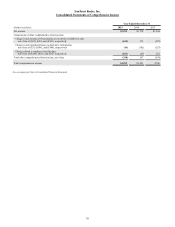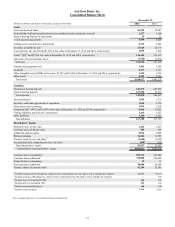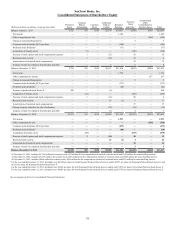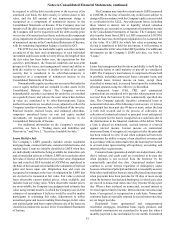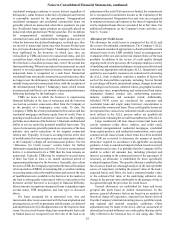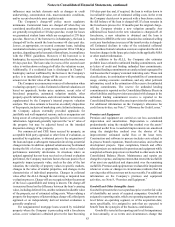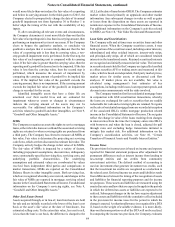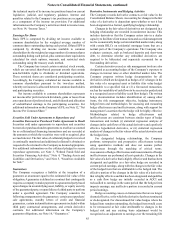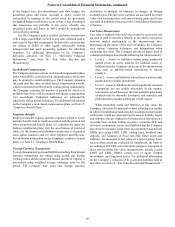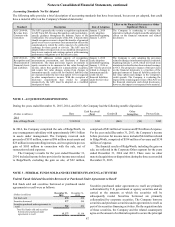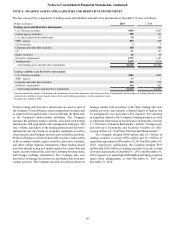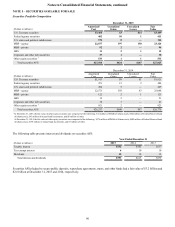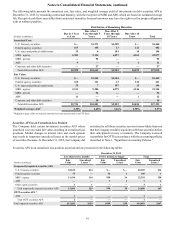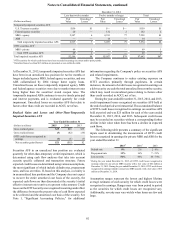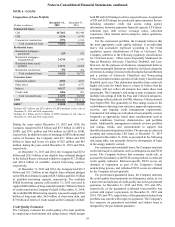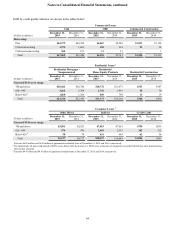SunTrust 2015 Annual Report Download - page 114
Download and view the complete annual report
Please find page 114 of the 2015 SunTrust annual report below. You can navigate through the pages in the report by either clicking on the pages listed below, or by using the keyword search tool below to find specific information within the annual report.Notes to Consolidated Financial Statements, continued
86
of the hedged item. For discontinued cash flow hedges, the
unrealized gains and losses recorded in AOCI would be
reclassified to earnings in the period when the previously
designated hedged cash flows occur unless it was determined
that transaction was probable to not occur, whereby any
unrealized gains and losses in AOCI would be immediately
reclassified to earnings.
It is the Company's policy to offset derivative transactions
with a single counterparty as well as any cash collateral paid to
and received from that counterparty for derivative contracts that
are subject to ISDA or other legally enforceable netting
arrangements and meet accounting guidance for offsetting
treatment. For additional information on the Company’s
derivative activities, see Note 17, “Derivative Financial
Instruments,” and Note 18, “Fair Value Election and
Measurement.”
Stock-Based Compensation
The Company sponsors various stock-based compensation plans
under which RSUs, restricted stock, and performance stock units
may be granted to certain employees. The Company measures
the grant date fair value of stock-based compensation awards,
which is expensed over the award's vesting period. Additionally,
the Company estimates the number of awards for which it is
probable that service will be rendered and adjusts compensation
cost accordingly. Estimated forfeitures are subsequently
adjusted to reflect actual forfeitures. For additional information
on the Company’s stock-based compensation plans, see Note 15,
“Employee Benefit Plans.”
Employee Benefits
Employee benefits expense includes expenses related to (i) net
periodic benefit costs or credits associated with the pension and
other postretirement benefit plans, (ii) contributions under the
defined contribution plans, (iii) the amortization of restricted
stock, (iv) the issuance of performance stock units, (v) historical
stock option issuances, and (vi) other employee benefits costs.
For additional information on the Company's employee benefit
plans, see Note 15, “Employee Benefit Plans.”
Foreign Currency Transactions
Foreign denominated assets and liabilities resulting from foreign
currency transactions are valued using period end foreign
exchange rates and the associated interest income or expense is
determined using weighted average exchange rates for the
period. The Company may enter into foreign currency
derivatives to mitigate its exposure to changes in foreign
exchange rates. The derivative contracts are accounted for at fair
value on a recurring basis with any resulting gains and losses
recorded in noninterest income in the Consolidated Statements
of Income.
Fair Value Measurement
Fair value is defined as the price that would be received to sell
an asset or paid to transfer a liability in an orderly transaction
between market participants at the measurement date.
Depending on the nature of the asset or liability, the Company
uses various valuation techniques and assumptions when
estimating fair value. The Company prioritizes inputs used in
valuation techniques based on the following fair value hierarchy:
• Level 1 – Assets or liabilities valued using unadjusted
quoted prices in active markets for identical assets or
liabilities that the Company can access at the measurement
date, such as publicly-traded instruments or futures
contracts
• Level 2 – Assets and liabilities valued based on observable
market data for similar instruments
• Level 3 – Assets or liabilities for which significant valuation
assumptions are not readily observable in the market;
instruments valued based on the best available data, some
of which may be internally developed, and considers risk
premiums that a market participant would require
When measuring assets and liabilities at fair value, the
Company considers the principal or most advantageous market
in which it would transact and considers assumptions that market
participants would use when pricing the asset or liability. Assets
and liabilities that are required to be measured at fair value on a
recurring basis include trading securities, securities AFS, and
derivative instruments. Assets and liabilities that the Company
has elected to measure at fair value on a recurring basis include
MSRs and certain LHFS, LHFI, trading loans, brokered time
deposits, and issuances of fixed rate debt. Other assets and
liabilities are measured at fair value on a non-recurring basis,
such as when assets are evaluated for impairment, the basis of
accounting is LOCOM, or for disclosure purposes. Examples of
these non-recurring fair value measurements include certain
LHFS and LHFI, OREO, certain cost or equity method
investments, and long-lived assets. For additional information
on the Company’s valuation of its assets and liabilities held at
fair value, see Note 18, “Fair Value Election and Measurement.”


